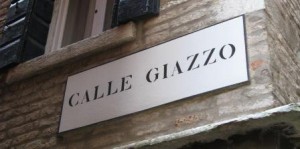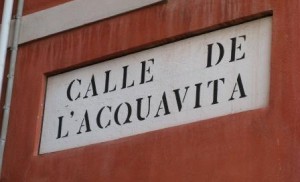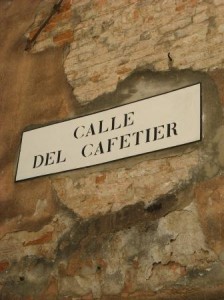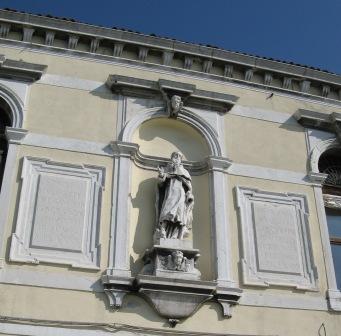
If someone in Venice were to ask me where I live, the generic answer would be “Castello,” which is the name of the sestiere, or one of the six neighborhoods into which Venice is divided. But that’s just a little too generic, considering that Castello is fairly large and has several hundred little subsets with all sorts of variations ranging from the sublime to the moderately mystifying.
The more precise answer is “Via Garibaldi.” We don’t actually live right there — we’re down beyond the end of it. But it’s an answer which represents not only geographical coordinates and a zip code, but an entire biosphere of its own with its own history and climate and fauna, a zone which to Venetians of other sestieri still connotes verging on the exotic, even vaguely hazardous.
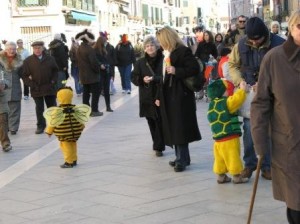
Once, when we were living in Dorsoduro, we overheard a mother snapping at her kid: “Stop shouting! You sound just like somebody from Castello!” And when we moved away — to Castello, of all places — Lino could hardly believe how far down in the world he had come. To his relatives, he might as well have gone to Tasmania. In fact, Tasmania would have made some sense. But Castello?
Many, if not most, people who visit Venice think of the city of palaces and monuments, and maybe also some trendy boutiques and clever little galleries. Our part of Venice is a gristly precinct beyond and behind the Arsenal. The Arsenal was the shipyard where Venice’s fleets were built, the foundation on which Venetian power — economic, military, political — rested. It’s thanks to the Arsenal that all those palaces and monuments exist, so Castello doesn’t have to apologize to anyone if it has chosen to remain in its primordial state. During Venice’s Great Days there were as many as 10,000 people working in the Arsenal, and their dwellings and relatives surrounding it constituted what amounted to a company town. Although very few, if any, locals still work in the Arsenal, I’m convinced there are people here who still haven’t discovered fire.
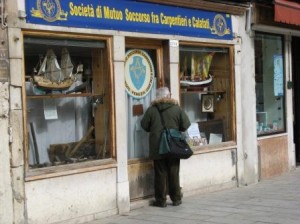
If Venice isn’t a place for everybody, Castello is even less so. And Via Garibaldi is the axis of a Hogarthian world where the men’s bodies swarm with tattoos; where men and women alike use hand-hewn phrases which can’t be translated and shouldn’t be repeated, and their rampant children have two basic ways of communicating: Yelling and crying. They’re a lot like London’s East Enders (denizens of another once-great seaport enclave) — tough, practical, unromantic yet sentimental homebodies to whom family and neighborhood are the universe, where grown men call each other “love” and women call each other “girls.” It’s not that they don’t know there’s a world out there, they just don’t find it all that interesting.
I love Venice in a complicated way that I don’t understand very well. In the midst of the obvious beauty and grandeur and all, the city is also composed of so many aspects which verge on ugliness but which, strangely, also have their own sort of allure. Nelson Algren once wrote that “It isn’t hard to love a town for its greater and lesser towers … but you never truly love it till you can love its alleys too.” You discover this in unexpected moments and glimpses, where she doesn’t mind you seeing her without her girdle: no excuses, no apologies.
The “alleys” would be out here, with the ingenious, illegal, improvised sewer outflows, and the “What, me worry?” deposits of dog poop and the hand-lettered signs vilifying the anonymous neighbor who has left his bag of garbage under your window, and the mismatched lifelong friends in the bar shouting at each other — the one who’s right and the one who’s wrong — about something that happened years ago. In fact, they’re both right. Or wrong.

This is not nostalgie de la boue; many things about life down here in the bilges range from infuriating to only slightly flinch-worthy. Then there are the aspects you can’t easily categorize — say, the septic tank somewhere on the other side of our canal which for far too long desperately needed pumping out. When we had company for dinner I used to pray that the wind wouldn’t shift. They say you can get used to anything, but I’m here to tell you: Not that.
I was walking down the via Garibaldi one early evening; there was a middle-aged Venetian couple coming toward me.
There had been a few airplane crashes that month: One in the sea just outside Palermo, another that hit near Athens, now one in Venezuela somewhere.
Anyway, I reach earshot just as the woman is saying to her husband, “Not me. I’ll never go on an airplane. Forget it.”
He says, “What about a ship?”
“Not even a ship. I’m staying home, I’m not going anywhere. If I die, I’m going to die right here in Via Garibaldi.” (Wait a minute — “If” you die?).
That’s what the true voice of a neighborhood sounds like — especially this one. Via Garibaldi to the bitter end.
I’m with her.



